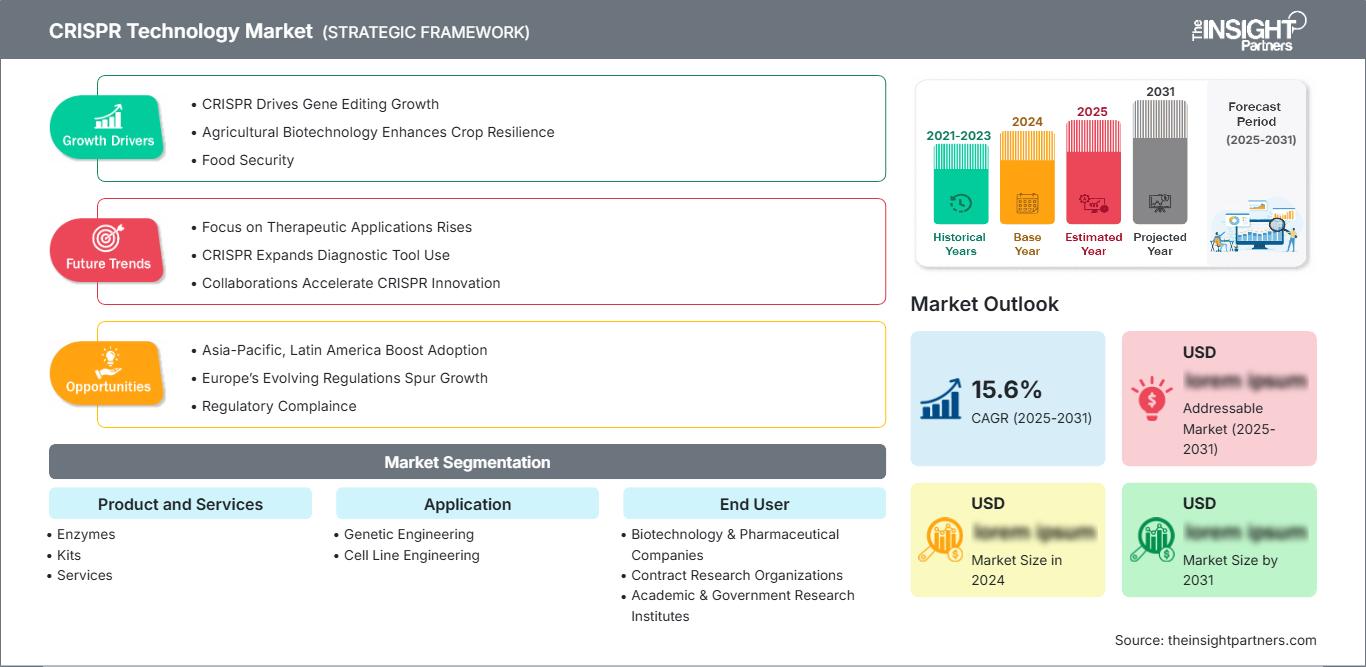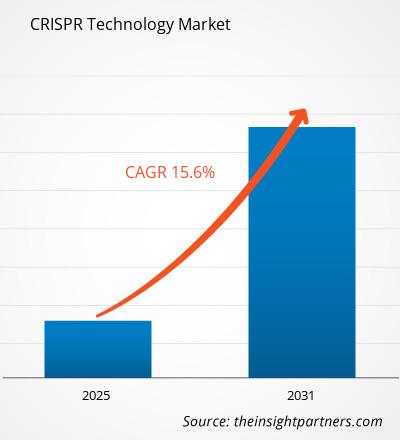Der Markt für CRISPR-Technologie wird bis 2031 voraussichtlich ein Volumen von 8.147 Millionen US-Dollar erreichen. Für den Zeitraum 2025–2031 wird eine durchschnittliche jährliche Wachstumsrate (CAGR) von 17,7 % erwartet.
Der Bericht zum CRISPR-Technologiemarkt analysiert Produkte und Dienstleistungen, Anwendungen und Endnutzer. Er bietet einen regionalen Überblick, der wichtige Märkte und Länder hervorhebt und so eine globale Perspektive gewährleistet. Die Marktbewertungen erfolgen in US-Dollar (US$) und ermöglichen ein umfassendes Verständnis der Marktdynamik, der Wachstumstrends und der Wettbewerbslandschaft in den verschiedenen Segmenten. Diese Erkenntnisse helfen Stakeholdern, Chancen zu erkennen und fundierte Entscheidungen in diesem sich schnell verändernden Umfeld zu treffen.
Zweck des Berichts
Der Bericht zum CRISPR-Technologiemarkt von The Insight Partners beschreibt die aktuelle Marktlage und das zukünftige Wachstum sowie die wichtigsten Treiber, Herausforderungen und Chancen. Dies wird verschiedenen Akteuren im Geschäftsbereich Einblicke ermöglichen, wie beispielsweise:
- Technologieanbieter/Hersteller: Um die sich entwickelnde Marktdynamik zu verstehen und potenzielle Wachstumschancen zu erkennen, können sie fundierte strategische Entscheidungen treffen.
- Investoren: Um eine umfassende Trendanalyse hinsichtlich Marktwachstumsrate, Finanzprognosen und Chancen entlang der Wertschöpfungskette durchzuführen.
- Regulierungsbehörden: Um Richtlinien zu regulieren und Aktivitäten auf dem Markt zu überwachen, mit dem Ziel, Missbrauch zu minimieren, das Vertrauen der Anleger zu wahren und die Integrität und Stabilität des Marktes zu gewährleisten.
Marktsegmentierung der CRISPR-Technologie: Produkte und Dienstleistungen
- Enzyme
- Kits
- Dienstleistungen
Anwendung
- Gentechnik
- Zelllinienentwicklung
Endnutzer
- Biotechnologie- und Pharmaunternehmen
- Auftragsforschungsinstitute
- Akademische und staatliche Forschungseinrichtungen
Geografie
- Nordamerika
- Europa
- Asien-Pazifik
- Süd- und Mittelamerika
Sie erhalten kostenlos Anpassungen an jedem Bericht, einschließlich Teilen dieses Berichts oder einer Analyse auf Länderebene, eines Excel-Datenpakets sowie tolle Angebote und Rabatte für Start-ups und Universitäten.
CRISPR-Technologiemarkt: Strategische Einblicke

- Holen Sie sich die wichtigsten Markttrends aus diesem Bericht.Dieses KOSTENLOSE Beispiel umfasst Datenanalysen, die von Markttrends bis hin zu Schätzungen und Prognosen reichen.
Wachstumstreiber des CRISPR-Technologiemarktes
- CRISPR treibt das Wachstum der Genomeditierung voran: Die CRISPR-Technologie beschleunigt die Genomeditierung zur Behandlung genetischer Erkrankungen und ist somit der Haupttreiber für das Wachstum des CRISPR-Technologiemarktes. Darüber hinaus ermöglicht CRISPR die präzise Modifizierung von DNA und innovative Behandlungsmethoden für Krankheiten, insbesondere Krebs, Mukoviszidose und Blutkrankheiten. Dies wiederum trägt zum Wachstum und Marktanteil der CRISPR-Technologie bei. Marktberichte deuten darauf hin, dass Fortschritte in der personalisierten Medizin das Wachstum des CRISPR-Technologiemarktes weiter ankurbeln könnten.
- Agrarbiotechnologie verbessert die Widerstandsfähigkeit von Nutzpflanzen: In der Agrarbiotechnologie, die CRISPR-Technologie nutzt, sind in letzter Zeit große Fortschritte zu verzeichnen. Dies trägt dazu bei, Nutzpflanzen resistenter gegen Schädlinge, Krankheiten und bestimmte Klimaveränderungen zu machen.
- Ernährungssicherheit: Basierend auf diesen Entwicklungen belegt die Marktanalyse der CRISPR-Technologie deren Trend und die Aussichten auf langfristiges Wachstum. Angesichts der wachsenden Besorgnis um die Ernährungssicherheit hat die Anwendung der CRISPR-Technologie zur Steigerung der Ernteerträge das Marktvolumen erhöht und vermehrt Investitionen angezogen.
Zukunftstrends des CRISPR-Technologiemarktes
- Zunehmender Fokus auf therapeutische Anwendungen: Ein wichtiger Trend auf dem Markt ist die verstärkte Fokussierung der Aktivitäten auf die therapeutischen Anwendungen der CRISPR-Technologie. Führende Akteure konzentrieren ihre Marktstrategien daher auf die Entwicklung von Gentherapien für Krebs und genetische Erkrankungen sowie andere schwere Krankheiten. Dieser zunehmende Fokus, zusammen mit der Marktdynamik und der SWOT-Analyse, fördert die Wettbewerbsdifferenzierung und treibt somit das Marktwachstum an. Prognosen zufolge wird die Nachfrage nach CRISPR-basierten Therapeutika stark ansteigen und damit die Marktstruktur und die wichtigsten Strategien prägen.
- CRISPR erweitert Einsatzmöglichkeiten in der Diagnostik: Die CRISPR-Technologie findet zunehmend Anwendung in der Diagnostik, insbesondere beim Nachweis von Infektionskrankheiten wie COVID-19. Eine Folge dieser Trends ist die Entwicklung neuer Diagnoseplattformen, die dem Markt neue Chancen eröffnen. Die PEST-Analyse zeigt ein günstiges technologisches und regulatorisches Umfeld, das diesen Trend begünstigt. Da wichtige Akteure solche Marktstrategien anwenden, prognostiziert die Marktprognose für die CRISPR-Technologie ein starkes Wachstum im Diagnostiksektor, das zum Gesamtwachstum des CRISPR-Technologiemarktes beiträgt.
- Kooperationen beschleunigen die CRISPR-Innovation: Die zunehmende Zusammenarbeit zwischen akademischen Einrichtungen und Biotechnologieunternehmen beschleunigt die Innovation in dieser Technologie. Basierend auf der Marktprognose und der SWOT-Analyse werden diese Allianzen eine führende Rolle bei der Gestaltung zukünftiger Strategien spielen, die es den wichtigsten Marktteilnehmern ermöglichen, ihre Wettbewerbsposition zu stärken.
Marktchancen für die CRISPR-Technologie
- Asien-Pazifik und Lateinamerika fördern die Anwendung: Geografisch gesehen entwickeln sich CRISPR-Anwendungen in der Landwirtschaft beispielsweise in Regionen wie dem Asien-Pazifik-Raum und Lateinamerika zu einem vielversprechenden Markt. Diese Regionen stehen vor wachsenden Herausforderungen wie Ernährungssicherheit und Klimawandel, bei denen die CRISPR-Technologie durch die Entwicklung widerstandsfähiger Nutzpflanzen hilfreich sein kann. Branchenlandschaftsanalyse: Unternehmen, die sich in diesen aufstrebenden Märkten auf die Landwirtschaft konzentrieren, können dies nutzen, um ihren Marktanteil auszubauen, insbesondere angesichts der steigenden Nachfrage nach nachhaltigerer Lebensmittelproduktion in diesen Regionen.
- Europas sich entwickelnde Regulierungen fördern das Wachstum: Europa bietet daher angesichts des sich stetig weiterentwickelnden regulatorischen Umfelds im Bereich der Genomeditierung vielversprechende Chancen.
- Regulatorische Konformität: Die im Allgemeinen konservativen europäischen Regulierungsbehörden sind nun offener für den Einsatz der CRISPR-Technologie in Landwirtschaft und Gesundheitswesen. Diese Wettbewerbsanalyse legt nahe, dass Unternehmen, die stark in Compliance und Innovation investieren, sich in dieser Region eine starke Position sichern werden. Unternehmen, die dieses Umfeld erfolgreich nutzen, werden gute Wachstumschancen finden und somit Marktanteile im Bereich der CRISPR-Technologie in einer für ihren wissenschaftlichen Fortschritt bekannten Region gewinnen.
Markt für CRISPR-Technologie
Die regionalen Trends und Einflussfaktoren auf den Markt für CRISPR-Technologie im gesamten Prognosezeitraum wurden von den Analysten von The Insight Partners ausführlich erläutert. Dieser Abschnitt behandelt außerdem die Marktsegmente und die geografische Verteilung des Marktes für das Management von Herzrhythmusstörungen in Nordamerika, Europa, dem asiatisch-pazifischen Raum, dem Nahen Osten und Afrika sowie Süd- und Mittelamerika.
Umfang des Marktberichts zur CRISPR-Technologie
| Berichtsattribut | Einzelheiten |
|---|---|
| Marktgröße in 2024 | US$ XX Million |
| Marktgröße nach 2031 | US$ 8,146.82 Million |
| Globale CAGR (2025 - 2031) | 17.7% |
| Historische Daten | 2021-2023 |
| Prognosezeitraum | 2025-2031 |
| Abgedeckte Segmente |
By Produkte und Dienstleistungen
|
| Abgedeckte Regionen und Länder | Nordamerika
|
| Marktführer und wichtige Unternehmensprofile |
|
Dichte der Akteure auf dem Markt für CRISPR-Technologie: Auswirkungen auf die Geschäftsdynamik
Der Markt für CRISPR-Technologie wächst rasant, angetrieben durch die steigende Nachfrage der Endnutzer. Gründe hierfür sind unter anderem sich wandelnde Verbraucherpräferenzen, technologische Fortschritte und ein wachsendes Bewusstsein für die Vorteile des Produkts. Mit steigender Nachfrage erweitern Unternehmen ihr Angebot, entwickeln innovative Lösungen, um den Bedürfnissen der Verbraucher gerecht zu werden, und nutzen neue Trends, was das Marktwachstum zusätzlich beflügelt.

- Holen Sie sich die CRISPR-Technologiemarkt Übersicht der wichtigsten Akteure
Wichtigste Verkaufsargumente
- Umfassende Abdeckung: Der Bericht bietet eine umfassende Analyse der Produkte, Dienstleistungen, Typen und Endnutzer des CRISPR-Technologie-Marktes und vermittelt so ein ganzheitliches Bild.
- Expertenanalyse: Der Bericht basiert auf dem fundierten Wissen von Branchenexperten und Analysten.
- Aktuelle Informationen: Der Bericht gewährleistet Geschäftsrelevanz durch die Berücksichtigung aktueller Informationen und Datentrends.
- Anpassungsmöglichkeiten: Dieser Bericht kann an spezifische Kundenanforderungen angepasst werden und sich optimal in die Geschäftsstrategien integrieren.
Der Forschungsbericht zum CRISPR-Technologie-Markt kann somit maßgeblich dazu beitragen, das Branchenszenario und die Wachstumsaussichten zu entschlüsseln und zu verstehen. Auch wenn einige berechtigte Bedenken bestehen, überwiegen die Vorteile dieses Berichts insgesamt die Nachteile.
- Historische Analyse (2 Jahre), Basisjahr, Prognose (7 Jahre) mit CAGR
- PEST- und SWOT-Analyse
- Marktgröße Wert/Volumen – Global, Regional, Land
- Branchen- und Wettbewerbslandschaft
- Excel-Datensatz
Aktuelle Berichte
Erfahrungsberichte
Grund zum Kauf
- Fundierte Entscheidungsfindung
- Marktdynamik verstehen
- Wettbewerbsanalyse
- Kundeneinblicke
- Marktprognosen
- Risikominimierung
- Strategische Planung
- Investitionsbegründung
- Identifizierung neuer Märkte
- Verbesserung von Marketingstrategien
- Steigerung der Betriebseffizienz
- Anpassung an regulatorische Trends




















 Kostenlose Probe anfordern für - CRISPR-Technologiemarkt
Kostenlose Probe anfordern für - CRISPR-Technologiemarkt